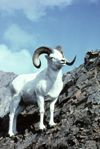 |
 | |
  | |
|
|
|
|
Denali National Park and Preserve
Dall Sheep
|
|
|
|
|
|
 |
 |
| NPS Photo | | Dall Sheep ram |
 |
Dall sheep are prevalent throughout the high mountains within the eastern and western-most portions of the park. They use the ridges and steep slopes for feeding and resting, and the rocks and crags to elude predators. The population within the original park boundary is of great interest to wildlife managers because it is one of the few populations in North America that is not currently hunted and still shares its range with a natural complement of large predators.
Male Dall sheep are called rams and are distinguished from females, called ewes, by their massive curling horns. Adult rams live in bands that seldom associate with ewe groups except during the mating season, or rut, in late November and early December. The head butting that rams are known for is the way males establish their reproductive rank. These clashes occur intermittently throughout the year but are most dramatic during the rut when rams compete with each other to mate with ewes.
Rams resemble ewes until they are about 3 years old. After that, continued horn growth makes them easily distinguishable. Their horns grow steadily during spring, summer, and early fall. In late fall or winter horn growth slows and eventually ceases. This is probably a result of changes in body chemistry during the rut. This pattern of horn growth results in rings called annuli that are spaced along the length of the horn. A sheep’s age can be accurately determined by counting these annuli. Researchers have recorded rams as old as 16 years and ewes as old as 19 years. More typically, a 12-year-old sheep is considered very old. As rams mature, their horns form a circle when seen from the side. Ram horns reach half a circle in about two or three years, three-quarters of a circle in four to five years, and a full circle or "curl" in seven to eight years. Dall rams normally do not breed successfully until they approach dominance rank (at full curl age and size).
Ewes have shorter, more slender, slightly curved horns. Normally, ewes have their first lamb at age 3 and produce one lamb annually. In late May or early June as "lambing" approaches, ewes seek solitude and protection from predators in the most rugged cliffs available on their spring ranges. Ewes produce a single lamb, and the ewe-lamb pairs remain in the "lambing cliffs" a few days until the lambs are strong enough to travel. Lambs begin feeding on vegetation within a week after birth and are usually weaned by October.
The diets of Dall sheep vary from range to range. During summer, food is abundant, and a wider variety of plants are consumed. Winter diet is much more limited and consists primarily of lichen and moss. Dall sheep visit mineral licks during the spring often traveling many miles to eat the soil at these sites.
|
|

|
 |
|
|
|
|
|
 |
|
Did You Know?
Did you know that Mount McKinley National Park was originally created to protect mammals, not because of the majestic mountain?
|
|
|
|
Last Updated: October 18, 2006 at 12:17 EST |






